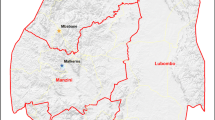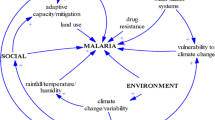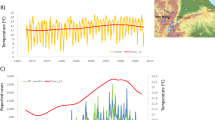Abstract
To compare internal migration and temperature as factors behind the decreasing trend in malaria deaths observed in Venezuela from 1905 to 1945, linear autoregressive models are fitted to a historical dataset. The model that only incorporates internal migration is the one with the best fit. The decreasing trend in malaria deaths in Venezuela, from 1905 to 1945, is not explained by a trend in mean annual temperature, but it is associated with an increase in the proportion of population in the Capital District, during a time period when the area was the principal attractor of migrations within the country.
Similar content being viewed by others
Introduction
One of the main results of the dynamical study of populations is that they are subject to the effect of endogenous and exogenous factors (Turchin 2003). The endogenous factors are always present in the population and account for the interactions that individuals within a population have on themselves. By contrast, exogenous factors account for the effects of events that occur independently and outside the population. For example, climate may act as an exogenous factor if it determines the seasonality in the numbers of individuals of an insect population. However, when examined in the context of a human disease, the latter can include phenomena as diverse as school terms, harvest times, or migrations due to socio-economic and/or political factors (e.g., Martens and Hall 2000).
Miguel Otero-Silva, one of the most-celebrated Venezuelan writers, won the 1955 National Prize of Literature for his novel Casas Muertas (1955). This novel is a description of the decline of Ortiz, a town in the central plains of Venezuela, due to continuous deaths by severe epidemics of malaria and the migration of people to big cities and oil fields. The novel’s descriptions of migration from the central plains and coastal regions of Venezuela to the Capital District (i.e., Caracas) and oil-extracting regions have been documented by a number of studies (Gabaldón and Guia de Perez 1946; Gabaldón 1949; Ramos-Ojeda 1999).
Although it has been proposed that demographic factors of human populations play a key role as contextual determinants of malaria transmission (Bouma 2003; Hay et al. 2002; Shanks et al. 2005), most studies have focused on the effect of climate on malaria transmission. This is mainly due to the realization that malaria, like any biological phenomenon that includes organisms whose physiology is sensitive to their surrounding environment, is expected to be sensitive to climatic variables (Gabaldón and Guia de Perez 1946; Bouma and Dye 1997; Bouma 2003). In Venezuela, several studies have demonstrated the effect of the physical environment and climate on the epidemics of malaria (Barrera et al. 1999; Bouma and Dye 1997; Gagnon et al. 2002). However, none has addressed the effect of demographic factors in the trends observed on this disease. In the present paper, the effect of migration out of the endemic regions in Venezuela will be studied as a plausible cause of the diminishing trend in malaria deaths from 1905 to 1945.
Materials and methods
Data
The data on the number of malaria deaths used in the present study were published by Gabaldón and Guia de Perez (1946) and correspond to the total number of deaths attributed to malaria from 1905 to 1945. This time series is shown in Fig. 1a.
a Total number of malaria deaths in Venezuela from 1905 to 1945. b DC proportional population (UP) and the smoothing splines fit (solid line). This curve was used to interpolate the annual values for the DC proportional values. c Immigration/emigration ratios for: DC (solid line), Cojedes (dashed line), and Guarico (dotted line). The dot-dashed line is for ratios equal to 1. d Average temperature for Venezuela from 1905 to 1945
Migration data were published by Ramos-Ojeda (1999) and are available at the Universidad de Los Andes-Instituto de Investigaciones Economicas y Sociales website (http://iies.faces.ula.ve/censo/censoven.htm). Because the phenomenon of migration occurred at a nation-wide scale from all of the states with endemic malaria and because the Capital District (DC) of Venezuela was the main attractor of the internal migrations in the country during the period 1905–1945 (Ramos-Ojeda 1999), the proportion of Venezuelans living in the DC was used as proxy measurement of the internal migrations. This proportion of people (UP) is shown in Fig. 1b. To further illustrate the reasoning behind this choice, the DC is selected as an example of an attraction area (places with a positive migration rate, more immigration than emigration) and Cojedes and Guarico as examples of repulsion areas (negative migration rate). In these two latter states, malaria deaths also achieved some of the highest rates during the studied period. However, this pattern of emigration and endemic malaria was not exclusive to these two states; it was common in most of the states of the country (Gabaldón and Guia de Perez 1946). The ratios of immigrants to emigrants in these three political subdivisions are shown in Fig. 1c. A value of this ratio below one means that the region is losing inhabitants due to emigration, whereas a value above one means that a region is gaining inhabitants by immigration.
To test for an alternative hypothesis, namely, that the trend can be associated to climate, temperature data for the political area of Venezuela were obtained from the database for countries (Mitchell et al. 2002) of the Tyndall Centre, available at http://www.tyndall.ac.uk. This time series is shown in Fig. 1d.
Statistical analysis
To understand the autocorrelation structure of the deaths data, its autocorrelation function was inspected and showed a decreasing profile, similar to that of a first-order autoregressive process (Brockwell and Davis 2002). With this information on hand, simple first-order linear autoregressive models were fitted to the data using least squares. To test the hypothesis that the observed trend of decrease in the number of deaths (Y) was related to the emigration from endemic zones, the DC proportional population (UP) was used as a predictor. Due to the fact that censuses were done at irregular intervals of time, annual UP was interpolated using a smoothing splines fit (Venables and Ripley 2002). To test that the trend is more likely explained by a demographic factor like migration out of endemic areas than by temperature trends, a first model including temperature (T) and UP as predictors was fitted:
Such model was compared with simpler ones that did not include temperature:
or the DC proportional population:
All models have an intercept (μ) and assume the noise (ɛ) as normally, identically, and independently distributed with variance \( \sigma ^{2}_{\varepsilon } ,\,\varepsilon _{t} \sim N{\left( {0,\sigma ^{2}_{\varepsilon } } \right)} \).
Results
Table 1 shows the parameters for the three models. In the three models, the first-order autoregressive component was statistically significant. All models also explain a high amount of variance (R 2), in all cases more than 87%. In the first model, which included the DC proportional population and temperature, the latter was not statistically significant. The coefficient (β) for the DC proportional population was negative, indicating that the number of deaths decreased with an increasing population in the DC. The same pattern for β was observed in the second model, which did not include temperature. Although the coefficient (γ) was not statistically significant in the first model, it was positive, indicating that the number of deaths increased with temperature in the studied period. The coefficient (γ) was also positive in the third model, the one without the DC proportional population. However, this model violates the assumption of independence in the error (ɛ t ), making invalid the inferences based on it. Figure 2 shows the surface obtained by fitting the second model. This surface shows how the number of annual malaria deaths is an increasing function of its previous values and decreasing for the proportional population in the DC.
Surface fitted for the model with the DC proportional population and a first-order autoregressive term. Y(t) and Y(t + 1) represent the number of malaria deaths in the years t and t + 1, respectively. UP stands for the DC proportional population. For more details, see Eq. (2) in the text and Table 1 for parameter values
Discussion
Levins and Lopez (1999) argue that human biology is ultimately a socialized biology, as social factors are as important as the biological ones in shaping the ability of humans to cope with changing environments. Obviously, human diseases as an expression of human biology are as sensitive to social factors as they are to biological forces. The dataset analyzed in this paper was previously used to demonstrate the association between malaria cycles and the El Niño Southern Oscillation (ENSO; Bouma and Dye 1997). Such study did not attempt to explain the diminishing trend of malaria in Venezuela from 1905 to 1945. As its goal was to study the relationship between climate cycles and diseases cycles, it used standard techniques for the de-trending of non-stationary time series, giving some compelling evidence on the relationship between this climatic phenomenon, ENSO, and the epidemic outbreaks of malaria in Venezuela. However, due to such data manipulations, it could not explain the diminishing trend during this period of time, while also ruling out the likelihood of ENSO as a factor explaining such a trend.
The results of this paper show that, to explain such a trend, the simpler and best model with a very high goodness of fit uses the fraction of people living in the DC as the only predictor. This illustrates how migration out of endemic regions can be a plausible explanation for the diminishing trend in the annual number of malaria deaths. This is a very interesting pattern because for malaria, migration has usually been invoked as the cause for increasing trends by the introduction of parasites to new zones where populations are susceptible to the infection by the parasites, mainly because no herd immunity can be developed in the absence of parasites (Barrera et al. 1999; Hay et al. 2002; Martens and Hall 2000; Shanks et al. 2005), and not as a cause of its diminishing due to the movement of people out of high-risk zones. However, this result can be expected from theoretical results based on mathematical modeling. Torres-Sorando and Rodriguez (1997) and Rodriguez and Torres-Sorando (2001) have shown that migrations within population patches increase the threshold for the endemic establishment of malaria, making more likely its extinction when compared to a system where individuals live in a single-patch population.
As shown in the other two models, the plausibility of alternative explanations for the diminishing trend on malaria deaths based on temperature is unlikely. The model incorporating temperature together with DC proportional population showed temperature not to be a significant predictor, whereas the model only considering temperature as a predictor was inconsistent with the assumption of temporal independence in the variation of the observations.
Among other plausible reasons explaining the diminishing trend in malaria deaths, it is important to take into account how the Venezuelan public policy towards the disease changed by the mid-1930s. Beginning in 1936, efforts led by Arnoldo Gabaldón made malaria a priority in the health sector, pushing the creation of laws and the development of institutions to solve this public health problem. Among the latter, a key role was played by the División de Malariologia, a public office in charge of the control of malaria, that promoted and funded basic and applied research on malaria and that also implemented some measurements of control such as: the free distribution of quinine in endemic zones, the sanitation of urban centers by draining mosquito-breeding pools, and the spraying of insecticides, mainly DDT (Gutierrez 1998). Unfortunately, no detailed data on the implementation of such policies are readily available like the demographic data used in this study. This points to the necessity for the development of databases on the historical records of infectious diseases and the interventions done to control them in Venezuela, and everywhere else in the world. However, and more importantly to the central argument of this paper, such actions were carried out by the end of the studied period (1936–1945), a time when the decreasing trend in cases have already begun as well as the migration out of the endemic regions.
Nevertheless, the results of this study should not be taken as evidence against the role that climate plays on the dynamics of transmission of this disease. Several studies have shown the importance of climatic variables on the cycles of epidemic outbreaks of this disease in Venezuela (Bouma and Dye 1997; Gagnon et al. 2002). Although human biology can be considered as a socialized one (Levins and Lopez 1999), it is also biological, being sensitive to environmental factors that are not necessarily impacted by human activities. However, when considering the effects of climate, it is also necessary to understand the effects that human activities have on climate. For example, a well-documented relationship between socially driven land-use changes and the environmental conditions that make malaria transmission suitable have been described (Lindblade et al. 2000). Thus, the understanding of the effects of climate and social factors on malaria should be studied taking into account the complexity of the dynamical feedback that both human activities and the natural environment have between themselves.
Finally, this work is an attempt to understand the role that socio-demographic changes have on the dynamics of malaria. As narrated by Otero-Silva (1955), internal migrations were one of the main characteristics of the Venezuelan society during the first half of the twentieth century. But not only were internal migrations common, as described by Otero-Silva (1961) in Oficina No. 1, the follow up to Casas Muertas; the standard of living of the Venezuelan population reportedly increased after these migrations as a direct result of wealth from oil. It is an open question to understand and quantify how the standard of living impacts the dynamics of transmission of malaria.
References
Barrera R, Grillet ME, Rangel Y, Berti J, Ache A (1999) Temporal and spatial patterns of malaria reinfection in northeastern Venezuela. Am J Trop Med Hyg 61:784–790
Bouma MJ (2003) Methodological problems and amendments to demonstrate effects of temperature on the epidemiology of malaria. A new perspective on the highland epidemics in Madagascar, 1972–1989. Trans R Soc Trop Med Hyg 97:133–139
Bouma MJ, Dye C (1997) Cycles of malaria associated with El Niño in Venezuela. J Am Med Assoc 278:1772–1774
Brockwell PJ, Davis RA (2002) Introduction to time series and forecasting, 2nd edn. Springer, Berlin Heidelberg New York
Gabaldón A (1949) The nation-wide campaign against malaria in Venezuela. Trans R Soc Trop Med Hyg 43:113–164
Gabaldón A, Guia de Perez G (1946) Mortalidad por malaria en Venezuela. I Bases estadisticas y distribucion geografica. Tijeretazos sobre Malaria 10:191–237
Gagnon AS, Smoyer-Tomic KE, Bush ABG (2002) The El Niño Southern Oscillation and malaria epidemics in South America. Int J Biometeorol 46:81–89
Gutierrez AT (1998) Tiempos de Guerra y Paz Arnoldo Gabaldón y la investigación sobre la malaria en Venezuela (1936–1990). Centro de Estudios del Desarrollo–Universidad Central de Venezuela, Caracas
Hay SI, Rogers DJ, Randolph SE, Stern DI, Cox J, Shanks GD, Snow RW (2002) Hot topic or hot air? Climate change and malaria resurgence in East African highlands. Trends Parasitol 18:530–534
Levins R, Lopez C (1999) Toward an ecosocial view of health. Int J Health Serv 29:261–293
Lindblade KA, Walker ED, Onapa AW, Katungu J, Wilson ML (2000) Land use change alters malaria transmission parameters by modifying temperature in a highland area of Uganda. Trop Med Int Health 5:263–274
Martens P, Hall L (2000) Malaria on the move: human population movement and malaria transmission. Emerg Infect Dis 6:103–109
Mitchell TD, Hulme M, New M (2002) Climate data for political areas. Area 34:109–112
Otero-Silva M (1955) Casas muertas. Losada, Buenos Aires
Otero-Silva M (1961) Oficina no. 1. Losada, Buenos Aires
Ramos-Ojeda O (1999) Venezuela: migracion neta y delimitacion de areas de atraccion y repulsion en el curso del Siglo XX. Rev Geog Venez 40:211–245
Rodriguez DJ, Torres-Sorando L (2001) Models of infectious diseases in spatially heterogeneous environments. Bull Math Biol 65:547–571
Shanks GD, Hay SI, Omumbo JA, Snow RW (2005) Malaria in Kenya’s western highlands. Emerg Infect Dis 11:1425–1432
Torres-Sorando L, Rodriguez DJ (1997) Models of spatio-temporal dynamics in malaria. Ecol Model 104:231–240
Turchin P (2003) Complex population dynamics. Princeton University Press, Princeton
Venables WN, Ripley BD (2002) Modern applied statistics with S, 4th edn. Springer, Berlin Heidelberg New York
Acknowledgment
I’m very grateful to two anonymous referees, Casey Lynn Taylor, Sandra Lim Yap, and Shalene Jha for their comments in previous drafts of this manuscript. This work was supported by a grant from Fundación Polar, Caracas, Venezuela and Graduate Student Assistantships from the Department of Ecology and Evolutionary Biology (University of Michigan).
Author information
Authors and Affiliations
Corresponding author
Rights and permissions
About this article
Cite this article
Chaves, L.F. Casas Muertas and Oficina No. 1: internal migrations and malaria trends in Venezuela 1905–1945. Parasitol Res 101, 19–23 (2007). https://doi.org/10.1007/s00436-006-0427-1
Received:
Accepted:
Published:
Issue Date:
DOI: https://doi.org/10.1007/s00436-006-0427-1






